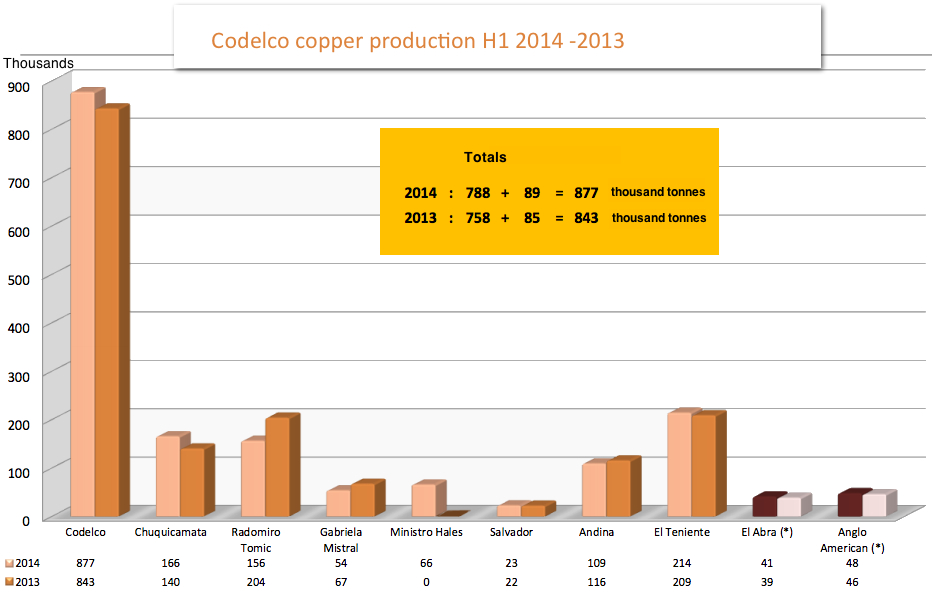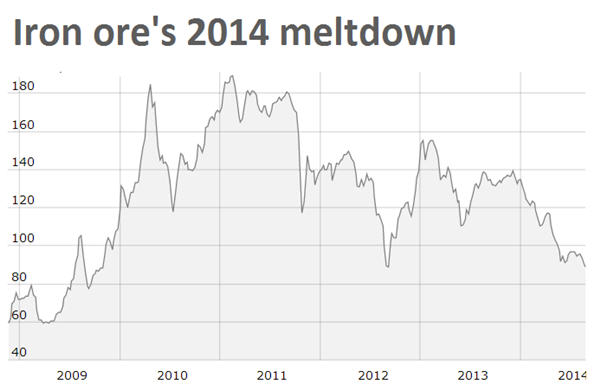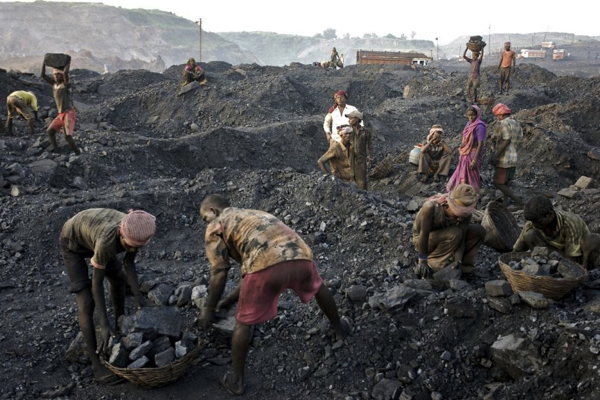Rick Rule: A briefing on private placements |
- Rick Rule: A briefing on private placements
- Freeport's $2 billion Chile sale hits snag
- Palladium price sets fresh 13-year high
- Codelco production up, copper price slump trims down profit
- Iron ore prices approaching 5-year low
- Coal shortage cripples half of India’s power plants
| Rick Rule: A briefing on private placements Posted: 29 Aug 2014 03:48 PM PDT Some investors are able to participate in private placements, where a company raises money by offering new shares. For US investors to participate in a private placement, they must be suitably qualified for the offering. Suitability depends on the exemptions under the Securities Act of 1933 through which the company is able to offer new shares. This loosely means that the investor must meet a certain threshold of net worth, income, or investable assets in order to participate. Private placements may be done by private or publicly trading companies. When a public company issues shares in a private placement, the new shares are not freely tradable, but must be held for a specified period of time, and must have their trading restriction lifted by the issuer's legal counsel before they can be sold. Rick Rule believes that if you're able to take part in these transactions, they could be attractive ways to take advantage of a recovery in natural resources: Let's define what a private placement is: a private issuance of new equity, new debt, or new warrants, from the treasury of a public or private issuer. It's not a secondary market transaction of securities that have already been issued, but rather an issue of new treasuries that isn't registered as a public offering. The advantage of private placements to the participant, in a traditional equity private placement, is that you often acquire an amount of stock that would be difficult to buy in the market for a small cap stock. You get to acquire the stock on terms that are set with the issuer, and not set by the vagaries of the bid and ask in the market. You may also be able to acuqire a warrant or a half-warrant along with your shares. A warrant is the right but not the obligation to buy more shares at a fixed price. It's this leverage in the warrant that has made Sprott Global an active participant in private placement markets for 30 years. Increasingly, other forms of private placements have become interesting to the people who run Sprott, myself included. We have found that, particularly in the United States, the costs of running a public company are so extraordinary that for ventures requiring less than $50 million in capital, we are better off funding private companies who avoid many of these costs. So, increasingly, at Sprott, we are investing by way of private equity transactions, or we're doing business in unincorporated joint ventures or partnerships. That's particularly true where our goal is income. We find that the public 'wrapper' — with the ongoing expense of a public listing, including legal, audit, and Sarbanes-Oxley fees — is inefficient and reduces the amount of income that can be distributed by the company to the investor. So one of the things that Sprott customers will be seeing with increased frequency in the next 5 years, particularly with regards to income-generating transactions, will be privately placed debt instruments from public issuers, oil and gas income opportunities, and infrastructure income from opportunities like terminals and pipelines. Theses are not publicly-trading equities, but rather, they are either shares in limited liability companies or in limited partnerships designed to funnel money directly to investors and that are exempt from filing fees, Sarbanes-Oxley, and registration statements. Readers should know that in order to participate in placements generally, they need to have a certain level of assets based upon the type of exemption the offering utilizes. Often, investors need to have $1 million in investable assets; in some cases, the investor must be a Qualified Purchaser, meaning they have $5 million in investable assets. It will be important for investors to understand, when analyzing private placements for their own portfolios, which of these classifications they are in. That's of course a function of their investable capital. If you are an US accredited investor, you can complete and return this form, which will enable you to hear about our upcoming opportunities. If you are an investor from another jurisdiction, please contact us at (760) 444-5298/emailhbonner@sprottglobal.com to learn more. Note private placements involve risks, as the companies that are financed can perform poorly, and can be highly illiquid. P.S.: Not a subscriber? Click here to get Sprott's Thoughts, and you'll also receive a free electronic copy of the Sprott Gold Book. This information is for information purposes only and is not intended to be an offer or solicitation for the sale of any financial product or service or a recommendation or determination by Sprott Global Resource Investments Ltd. that any investment strategy is suitable for a specific investor. Investors should seek financial advice regarding the suitability of any investment strategy based on the objectives of the investor, financial situation, investment horizon, and their particular needs. This information is not intended to provide financial, tax, legal, accounting or other professional advice since such advice always requires consideration of individual circumstances. The products discussed herein are not insured by the FDIC or any other governmental agency, are subject to risks, including a possible loss of the principal amount invested. Generally, natural resources investments are more volatile on a daily basis and have higher headline risk than other sectors as they tend to be more sensitive to economic data, political and regulatory events as well as underlying commodity prices. Natural resource investments are influenced by the price of underlying commodities like oil, gas, metals, coal, etc.; several of which trade on various exchanges and have price fluctuations based on short-term dynamics partly driven by demand/supply and nowadays also by investment flows. Natural resource investments tend to react more sensitively to global events and economic data than other sectors, whether it is a natural disaster like an earthquake, political upheaval in the Middle East or release of employment data in the U.S. Low priced securities can be very risky and may result in the loss of part or all of your investment. Because of significant volatility, large dealer spreads and very limited market liquidity, typically you will not be able to sell a low priced security immediately back to the dealer at the same price it sold the stock to you. In some cases, the stock may fall quickly in value. Investing in foreign markets may entail greater risks than those normally associated with domestic markets, such as political, currency, economic and market risks. You should carefully consider whether trading in low priced and international securities is suitable for you in light of your circumstances and financial resources. Past performance is no guarantee of future returns. Sprott Global, entities that it controls, family, friends, employees, associates, and others may hold positions in the securities it recommends to clients, and may sell the same at any time. |
| Freeport's $2 billion Chile sale hits snag Posted: 29 Aug 2014 02:38 PM PDT Freeport McMoRan's (NYSE:FCX) sale of a large Chilean mine to Canada's Lundin Mining (TSE:LUN) is being held up because of big changes to the South American country's tax regime. The WSJ reports Phoenix-based Freeport has been in negotiations with Lundin to sell its Candelaria copper mine for more than $2 billion, but the sale is being delayed because of uncertainty about planned new capital gains taxes. Broad tax reforms were agreed to by Chile's senate in July, but the legislation still has to be approved by the lower house. Freeport owns 80% of the open pit and underground gold-copper mine, one of four it operates on the continent. Candelaria in northern Chile's Atacama province last year produced 168,000 tonnes of copper. The company's South America operations produced 1.33 billion pounds of copper in 2013 and an expansion is under way at its massive Cerro Verde mine in Peru. Freeport and Lundin have joint ownership of the Tenke Fungurume copper mine in the Democratic Republic of the Congo, but Freeport has been looking to sell that stake too. Freeport, owner of the massive copper-gold Grasberg mine in Indonesia, has been selling off assets at it struggles with debts of nearly $21 billion. |
| Palladium price sets fresh 13-year high Posted: 29 Aug 2014 12:50 PM PDT
Palladium futures trading on New York's Nymex are now at the highest since February 2001 as news of Russian troops entering the east of the country raises concerns that the West will be forced to tighten sanctions against the number one supplier of the precious metal. The US and EU have already imposed restrictions on Russian imports of oil technology and have placed curbs on its defence and banking sectors, but so far supply of platinum and palladium have been mostly unaffected. PGMs are mainly used to clean emissions in automobiles and Europe's car industry is the number one customer of PGMs. Not everyone believes the tensions would affect the fundamentals of the industry. "In a nutshell, Russia needs the money, the EU needs the metal; it all boils down to politics, but the base case is business as usual," GFMS analyst Johann Wiebe told the Reuters Global Gold Forum on Friday. South Africa, where a devastating strike kept mined metal off markets for months, and Russia combined account for close to 80% of global supply of palladium and 70% of platinum output.
South Africa is the top supplier of platinum but with production slowly returning to pre-strike levels and without the Russian risk premium platinum prices have come under pressure. While palladium is up 26% this year, platinum has only managed gains of 3.5% in 2014. After a brief period above $1,500 in early July, platinum has also declined 6%. Expected demand has not materialized either. From expectations of a 6% jump in sales this year, the continent's carmakers only managed to shift around 3% more vehicles in the first half as Europe's largest economies look in danger of sliding back into recession. A slowing economy in China, the world's largest vehicle market where catalyst use skews towards palladium, is also clouding the outlook. Image of statue of Lenin in Illichivsk in the Odessa Oblast by lentina_x |
| Codelco production up, copper price slump trims down profit Posted: 29 Aug 2014 10:33 AM PDT Chilean state-owned Codelco, the world's No.1 copper producer, said Friday production during the first-half of the year increased 4%, boosted by its new Ministro Hales mine, but lower copper prices ate into profits. The giant miner of the industrial metal produced 788,000 tonnes of copper in the January to June period, compared to 758,000 in the same period last year. Higher ore grades and volumes at century-old Chuquicamata lifted output 26,000 tonnes, while Ministro Hales contributed 66,000 tonnes despite some start-up problems. Pre-tax profit dropped 27% in the first half to $1.3 billion, as the average copper price in the period fell around 8% to $3.14 a pound, Codelco said. The company is battling to maintain production levels against a backdrop of falling ore grades at its aging mines, as well as sliding copper price and rising costs, began using bacteria this week to make low-grade ores profitable. The technology, known as bioleaching, uses microorganisms to obtain copper from sulfide ores, which with current technology are usually considered unprofitable and left unprocessed. Copper accounts for 60% of Chile's exports and 15% of gross domestic product. |
| Iron ore prices approaching 5-year low Posted: 29 Aug 2014 08:16 AM PDT Prices for iron ore tumbled again Friday for the 10th day in a row, hitting levels close to those seen last in October 2009. The decline is the longest run of daily losses in two years and oversupply as well as China's unseen signs of recovery are to blame. Benchmark Australian ore, with a 62% iron content, dropped 0.1% to $87.62 a tonne, according to Metal Bulletin, bringing the monthly loss to 8.4% and the yearly one to over 35%. Figures provided by The Steel Index, however, contradict the above numbers. Spot price for the import of iron ore into China was, according to TSI, up 0.7% to $87.9 a tonne on Friday. The extent of the recent falls is now starting to have a serious impact on the share prices of the sector heavyweights, with Rio Tinto's (NYSE:RIO) stock sinking again Friday to $53.57 at 11:35 am in New York, totalling a 5% decline for the week. Vale (NYSE:VALE) was down 0.61% Friday to $13.03, yielding almost 5.3% this week, and BHP (ASX:BHP) lost 1.45% in Sydney, closing at $36.67. The steel-making raw material is vital to the profitability of many of these miners. They are spending billions of dollars ramping up output to meet anticipated future demand, and capture market share, while pushing the global market into surplus. Barclays Bank estimates that, assuming Chinese steel production grows at 5.1% per year, there will be a surplus of 79 million tonnes of seaborne iron ore this year and 67 million tonnes next year. UBS estimates a surplus of 74 million tonnes this year, with a possible oversupply of 267 million tonnes by 2016. Volatility here to stay Iron ore consultant Philip Kirchlechner told ABC News that while analysts believe prices will return to at least $95 a tonne towards the end of the year, volatility will continue. "Two years from now, Brazil will put … a big new mine into production. So in two years, you'll see again a pretty lumpy increase in output that will cause another slump [in] prices," he was quoted as saying. "So, this volatility will continue as supply tries to catch up with demand and then overshoots again, but in the short term I think prices will be pretty stable, around the $90 mark." The price slump, experts agree, could start to force high-cost Chinese miners out of the market. |
| Coal shortage cripples half of India’s power plants Posted: 29 Aug 2014 07:46 AM PDT Indian coal-based power plants are struggling to keep up with daily demand and 50% of them only have enough stocks to last about a week, the lowest level since one of the world's worst blackouts hit the country in 2012. Latest official data by the Central Electricity Authority show a sharp fall in power output on Thursday from a plant in Gujarat that left India more than 9,000 megawatts short of peak demand, Reuters reported. State-run NTPC's five power projects are running at a lower capacity due to inadequate fuel supply from Coal India (CIL) even as the demand soared in the central and northern parts of the current, IBNLive reported. Speaking to the upper house of parliament last month, the minister of state for power, coal and new and renewable energy called power utilities to increase coal imports and so avoid the every day more frequent blackouts. He also said CIL, the world's biggest producer of the fossil fuel, has been asked to enhance production of domestic coal. "The availability of coal in the country has been adversely affected due to coal scams during the previous government," the authority said, adding the current shortage at coal-powered plants was estimated in 84.71 million tonnes in the fiscal year to March 31, 2015. According to the authority, demand for coal-based power in the year will require 551.60 million tonnes of the mineral, whereas coal supplies are projected to be 466.89 mi. India's coal output hit 565 million tonnes in the fiscal year to March, making it the world's third-largest producer of the fossil fuel. It is also the fifth-biggest importer of coal and its ongoing crunch could offer a sales opportunity to exporters. Image by JT_Palmer|Flickr Commons. |
| You are subscribed to email updates from MINING.com To stop receiving these emails, you may unsubscribe now. | Email delivery powered by Google |
| Google Inc., 20 West Kinzie, Chicago IL USA 60610 | |






0 Comment for "Rick Rule: A briefing on private placements"